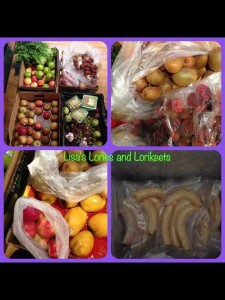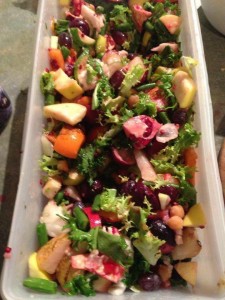DIET & NUTRITION – LORIES & LORIKEETS
In the wild Lories and Lorikeets main source of diet is pollen and nectar obtained from the various flowering blossoms and trees.
It is a common sight in Australia’s Eastern States to see flocks of lorikeets feeding in the flowering gum tree’s, Grevillia’s, bottle brush, banksia’s, camellia’s etc.
It is also common for them to visit fruit orchards where they have been known to cause considerable damage to crops and for this reason can be considered a pest.
In many cities and suburbs lorikeets have made themselves at home with the frequent feeds offered to them from gardens, decks and balconies and will commonly bring their young with them upon fledging from the nest.
Lories and Lorikeets are not essentially seed eating birds, however it has been documented them being observed eating small quantities of seed in the wild along with small grubs and insects.
To extract the nectar and pollen this group of birds have a unique bristle tongue, the constant offering of seeds to them can damage the bristles. They are also unique due to having a very undeveloped gizzard which prevents the birds ability to process and digest seed. So in captivity and for our wild visitors looking for a free feed – seed should not be provided. A better offering would be an assortment of fruit and or a commercially available pollen or nectar substitute.
Meeting the dietary requirements of this group has undergone considerable development since the early days of keeping them in captivity. The range of commercially available food now available has seen an explosion in the keeping of this group of birds. Unfortunately due to their specialised diet they are well known for their liquid faeces and can be very messy needing far more work cleaning and caring for than a typical parrot.
Their diet being made up of dry mix (pollen substitute) and wet mix (nectar substitute) fruit and vegetables contribute to added care and maintenance of this group. The wet mix and the fruit and vegetables can sour very quickly in our warm climate, the wet mix and fruit can go off, as well the fruit can ferment and turn vinegar. All uneaten wet mix, fruit and vegetables and bowls should be removed prior to this happening. As a guide each of our lorikeets receive approximately 20ml each of wet mix.
The Lories have a common habit of making their own wet mix by taking the dry mix to the water bowl and mixing themselves, this results in much waste and a water bowl that has a lot of dry mix sludge on the bottom that must be changed daily. On that note water for all birds should be checked and changed daily, in the case of lorikeets this is sometimes required numerous times throughout the day as they love water and love to play and bath in the water.
Because of their wet diet they are susceptible to common ailments like thrush, this is easily detectable and easily treated if done quickly by the use of Nilstat that can be purchased from your local chemist.
Once your lorikeets are used to getting a regular wet mix, they are probably the easiest group of birds to medicate if and when needed simply by adding the medication to the wet mix.
If you only have one or two lorikeets it is probably easier to purchaser one of the packaged dry and wet mixes available, most produce stores and pet shops now carry these on their shelves. Like most things the different brands may look similar but can vary considerably in the quality and nutritional content.
If you keep numerous lorikeets buying commercially available food can become expensive and you may like to purchase the ingredients and make your own, it’s not hard and you can save money.
We have too many lorikeets to justify purchasing a commercial mix and are set up to quickly and effortlessly make our own. We use 5kg of dry mix per day.
A highly regarded and commonly used dry mix with ingredient’s and quantities is :-
INGREDIENT’S AND QUANTITIES FOR DRY MIX
2 Cups of Rice Cereal (Farex)
2 Cups of Rice Flour
2 Cups of Egg and Biscuit
1 Cup of Dextrose (Glucodin)
1 Cup of Milk Powder
25 grams of Brewer’s yeast (special one from your local produce)
1 teaspoon Ornithon or Multi Vitamin in powder form
From batch to batch we will use different bases such as apple, banana, cheese and broccoli or plain rice flour.
In addition to dry mix being available at all times to our birds, they receive a wet mix every other day and on alternative days receive fruit and vegetables. Excess fruit can be put through a blender and poured into ice cube containers and frozen to be used at a later date.
For variety pureed baby fruit can be added to the wet mix.
If you have lorikeets in a conventional type aviary a large branch can be installed with blunt spikes protruding to enable placement of apple, orange, pear etc. to be secured or bunches of grapes hung off, the birds love this, we also freeze grapes and give to the birds on a hot day, they love to play with this and realize it’s a cool treat for them.
 Lorikeet Dry Mix (available in 5kg bags)
Lorikeet Dry Mix (available in 5kg bags)
DIET & NUTRITION – PARROTS
Birds in captivity rarely receive the full balanced diet compared to their wild counterparts. Wild birds have the advantage of knowing where various food sources are located at different times of the year and the ability to fly there to get it. This is not possible for a bird that is contained in a cage and relies upon its keeper for food.
Captive birds are totally reliant on us to provide the necessary variety of safe foods they require to enable living a full and healthy life. Those that have birds in aviaries with the ability to breed and reproduce have a greater responsibility to provide a diet that exceeds the birds minimum requirements without causing the birds to become overweight which is not in the best interest of the birds and will result in poor breeding results.
Generally in Australia there can be four categories of birds kept in captivity. Depending on which State or Territory you live will dictate the licence requirement for the keeping of birds and particular species of birds in each category.
This is a very basic list, numerous publications are available for each category which go into great detail on dietary requirements. The bird types given will and do cross over between category.
- SEED EATERS
- POLLEN AND NECTAR EATERS
- INSECTIVORES
- CARNIVORES
In recent years considerable development of dietary requirements has been achieved. This has resulted in ‘pellets’ being available to compliment a seed diet and or remove the necessity to provide seed at all.
Here at Lisa’s Lories and Lorikeets we have seed eaters and pollen / nectar eating birds.
Seed Eating Birds
A common problem that is seen with those that have a single bird as a pet or have a mixture of species in an aviary, is that all they are provided in their diet is a mixture of seed. Unfortunately this is not adequate to sustain the health or mental well being of the birds. There are as many types of seeds as there are quality of seeds. Each type of seed provides a different nutritional requirement. For example some seeds are high in iron some are high in fat, whilst others are high in carbs. Some types of seeds found in various seed mixes are useless depending on your species of birds and are simply included in the mix as ‘fillers’ – these are the seeds that your birds don’t eat and you throw in the bin each week. To prevent waste and reduce cost many breeders will buy there seed from the local produce store where the various seeds are available unmixed which enable the purchaser to pick and choose which seeds go into the mix that best suits the species of birds they keep. This is by far more beneficial to the birds. Keeping in mind that some of the bird seed suppliers nowadays do a very good premixed seed mix specific to species.
As mentioned previously, manufactured pellets are readily available and are a very popular alternative that can cover the entire dietary requirement to that of seeds.
We currently keep several species of seed eating birds, they are provided a quality seed or pellet mix daily.
All our birds are provided with a mix of fresh fruit and vegetables on alternative days, quantity being increased leading up to the breeding season or if chicks are being raised.
Our larger parrots, amazon, macaws and cockatoos receive a handful of mixed nuts in the shell whilst the smaller species receive a handful of mixed nuts that are shelled.
Some of the fruit and vege’s our birds receive include :-
Endive Apple
Baby Spinach Banana
Beans Kiwi Fruit
Chilli’s Passion Fruit
Corn Rockmelon
Cucumber Watermelon
Zucchini Honey Dew
Bean Sprouts Mango
Soaked and slightly cooked beans Pineapple
Nuts Strawberries
Corn Pomegranate
Bok Choy Persimmon
Celery and leaves Pear
Sweet Potato Stone Fruits
Carrot Grapes
Lentils Cherries
Peas All berries i.e. Blue berries
Providing such an assortment can become quite expensive depending on the number of birds you have. We are very fortunate that our local fruit shop owner provides all the above. Humans are a strange lot and if there is the slightest mark on the skin or is too ripe the produce will not be purchased. So rather than throwing out good produce you should discuss with your local fruit shop owner.
Generally speaking, caged birds have a rather dull and boring life. Variety in diet can provide a great source of mental stimulation which will keep them occupied for hours.
Some birds we have purchased over the years will not touch fruit and vege’s when provided to them and it is obvious they have no idea what it is as they have not seen it before. With time and perseverance these birds do eventually learn to enjoy their fruit and vege’s and look forward to getting them. Once on a good diet in no time their feathers and eye’s are brighter, they are more energetic and appear healthier and happier.
Having your birds used to eating fruit and vegetables has other benefits also, it enables easy administration of calcium when required by sprinkling calcium powder over the top, medication and worming can be added to a pureed mix.

